About KOZA
History of Koza
The history of the Koza area begins in 1871 (the 4th year of Meiji), when the Meiji government set up the area, previously a rural area owned by the local lord. This was to become the beginnings of Okinawa Prefecture. Then in 1908 (the 41st year of Meiji) the areas then known as Goekumagiri and Misatomagiri, under the Law for Creating Townships in Okinawa, changed their names to the towns of Goeku and Misato. From March of 1945, during the War, Okinawa City became a battlefield where one third of its population of twenty thousand people, namely five thousand three hundred people lost their lives. In September of 1945 (the 20th year of Showa), after the War ended, the population rapidly increased, bringing on city ordinances, in the center of the towns and villages which became refugee camps. Goeku Town became Koza, and Misato Town and Gushikawa areas became known as Maebara City. However, the following year, the area was divided back again to Goeku Town and Misato Town. In June of 1956 (the 31st year of Showa), Koshirai Town became known as Koza Town, and in the same year, the City of Koza was born.
-
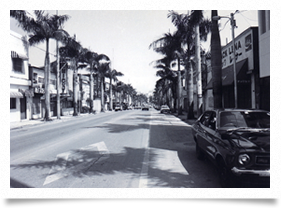
The now famous white colored Chuou Park Avenue was, up to 1982, widely known for its palm trees lining its neon-lit street.
-
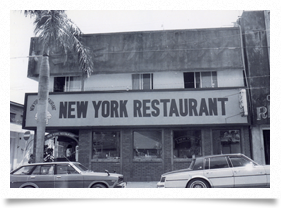
This is a photo of Koza's famous New York Restaurant. Not only foreigners living in Okinawa and locals, but also tourists frequented this place.
-
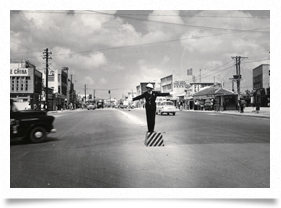
This is of the former Koya Intersection without any traffic lights. The police administered to the traffic.
The history of Okinawa City cannot be separated from the American Bases. The music in the city was nurtured along with the economic growth of the Bases.
After the War ended, the Kadena base was constructed near the town, and all kinds of drinking establishments and businesses geared for the American forces were born. The economy of Koza flourished quickly due to these new businesses. As jazz music was highly popular in America, there was a need for jazzbands in the Koza area. Jazz music could be heard flowing in the streets of Koza. In the 1960's, as rock and roll became popular, local musicians polished their playing skills eventually matching the American standard. Many famous bands came about at this time such as Condition Green, Murasaki, Canabis, and Medusa. At the same time, famous songs like Bashofu, Yuuna no Hana, Furusato no Ame, among others also were made by the renown music composer Tsuneo Fukuhara in this same town. Even to this day this music is still loved and known as Fukuhara Melody. When the War finished, in order to survive, Okinawans took in the American culture while also keeping its own traditions, bring about a mixing of cultures known here as a Stir-Fry Culture.
The holding of the All Island Eisa Contest has been for the purpose of decreasing Okinawa's economic dependence on the American Bases.
The way that the name of Eisa Town came about, was in part, due to the American Bases. 1956 was the year when the inhabitants of Okinawa rebelled against "The Melvin Price Report," which was a plan to buy land in bulk for military use at a fixed price. This is the year that the first All Island Eisa Contest was held. After the War, Koza was the area that developed through the commerce from the American Bases. As a reaction to the strong opposition to America's landbuying, the American Forces set up areas which became off limits to the general public. This caused great problems for the local businesses. Eisa has also been a symbol of the city's reconstruction, and as there were many young people living in Koza, their active participation in Eisa had raised the excitement in Eisa. It is said that this Contest came about as a way of restoring peoples' pride in their town. Because of this contest, Eisa has become even more popular and danced.
Japanese Frustration towards the American Occupation and Anti-War Songs Leading up to the Returning of Okinawa to Japan
In the year of 1970 (the 45th year of Showa), the Itoman Hit-and-Run Incident happened caused by an American serviceman, and in this same year, on December 20th, after a long period of local resentment of injustice by American servicemen, riots in Koza occurred. This influenced movements on human rights issues and the return of Okinawa to Japan. During the many years of the Vietnam War, anti-war sentiment brewed, and as a result, folk music became popular as a means to show solidarity against the War. A Kozan born Yutaka Sadoyama formed the Okinawa Folk Village and continued his work throughout Japan as a folksinger. 1972 (the 47th year of Showa) saw the year of a twenty-seven year long occupation of Okinawa end. In April of 74 (the 49th year of Showa), Koza Town merged with Misato Town to form Okinawa City, and also after this restoration to Japan, with a view to ridding itself of the great economic influence of American Bases, Okinawa City proclaimed itself an International Cultural Tourist City and has modernized many of its businesses and establishments to meet the needs of its people.
-

On the right you can see a white building, the Bank of the Ryukyu. This is the present-day Ryukyu Bank. This bank is still in the same place as it has always been, on the corner of the Koya Intersection.
-
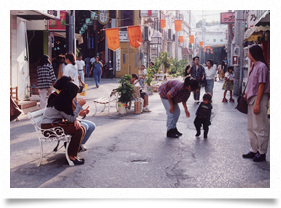
Even the present-day impressive brick road, Palmyra Road was laid with asphalt up to the 70's and was named the Rising Sun Street.
-
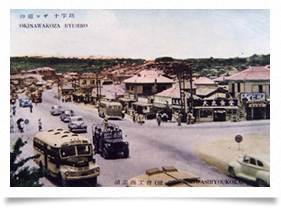
This is a photo of the Koza crossroads neighborhood that flourished as a hub of transportation in Okinawa City along with the Goya Crossing. This photo was taken before Koza City was merged when the area was called Misato Town. Public transportation back then was by a bus which looked like a cat.
The Unprecedented Okinawa Boom of the 1990's
At the beginning of the 1990's the Okinawan-born Rinken Band lead by Rinken Teruya achieved nationwide fame for its Okinawan Folk Music. The band "Nay nays,"produced by the Okinawan Folk Music singer, Sadao China, made its debut and performed mainly in the city. In 2003 local musicians got together and formed the band, Orange Range, and became a success. Even today many artists have come out of this collaboration of Okinawan musicians.
The Formation of Koza as a Musictown
In Okinawa City you can find many clubs with live music and Traditional Folk Bars. In addition to having various music festivals starting with the Peaceful Love Rock Festival, this city has truly become a Mecca for music. In 2006, thanks to a deeply rooted music culture, there started a movement to build a musictown, and in the following year, this was realized when facilities were opened to make Koza Musictown Area. Not only as a place where tourists can come, but also as a place to nurture next-generation musicians, this area has gathered attention, becoming a symbol for a new type of town.
-
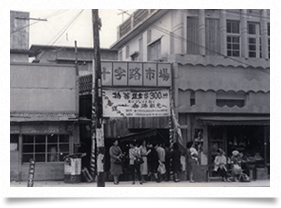
The arcade promenade known as Gintengai was the forerunner of the Crossroads Market.
-
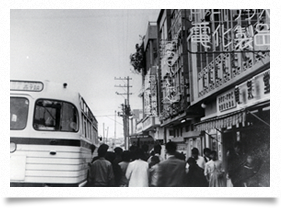
This is a photo of the Koya bus stop in the 60's. The old neon signs bring back the memories of the former town.
-
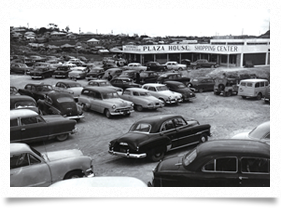
This is of a long line of cars driven by Americans living in Okinawa. This is Plaza House, which was the symbol of America back then.